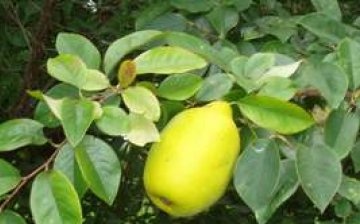Quince fruit
The quince fruit is a small deciduous tree that belongs to the genus Cydonia. Quince reaches a height of 5-8 meters and a width of 4-6 meters. The quince fruit has pome fruits of yellow or bright gold color, pear-shaped, the length reaches 7-12 centimeters, and the width is 6-9 centimeters.
Unripe quince fruits are green in color, they have dense gray-white fluff, which disappears after ripening. Quince leaves are arranged alternately, they are simple, up to 11 centimeters in length, have a solid edge and are densely pubescent with beautiful white fibers. In the spring, after the leaves, flowers bloom. The flowers are white or pink, 5 centimeters wide, have five petals.
Quince is a hardy fruit that requires a cold period of less than 7 degrees for flowering. The tree is self-fertile, with the help of cross fertilization, the yield can be increased. Fruit can be left on the tree to ripen more fully. Before the first frosts, the quince must be harvested.
Most varieties of this fruit are too astringent, hard and sour to be eaten raw. Therefore, they are used to make quince pudding and jelly, they are also fried, baked or stewed after peeling the skin. Quince is also used to make pies, jams, marmalade, apple sauces, wine, etc.
The value of quince is its versatility. She is both a vegetable and a fruit in the gastronomic sense. With its help, you can cook the first, second, third and compote with equal success. Quince has a positive effect on the digestive system.




I associate the quince fruit exclusively with quince juice, which my mom and dad often bought when I was little. I rarely see it directly in the form of a fruit, since it does not grow in our country.
I have been trying to grow quince for many years, but for some reason my first seedling sat in place for a long time and did not grow at all, and then it disappeared. I planted the second one, he started and it seems to be growing well. Hopefully in a year or two it will have fruit on it. I like the taste of quince very much.
The tree is quite unpretentious, there are litters that grow well in the middle lane. Another thing is that quince is only suitable for compotes or jam, although some hybrids with softer fruits may already have appeared.